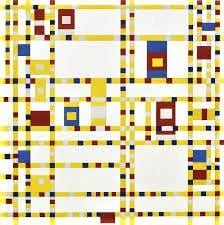During the years I lived in New York City I took up the habits of devouring the New York Times and the New Yorker. Some New York habits I just can’t seem to shake, especially the ones my husband David and I share.
“Here,” David says as he is reaching across the table between our reading chairs and handing me a recent New Yorker. “I think you’ll like this article,” he assures me. How well David knows my reading tastes. He’s on the mark with this one.
Under the heading titled “Field Trip”, follows “Red, Blue, Yellow”, musings by David Kortava. As the story goes there are two groups of MOMA curators on a pilgrimage. Divided into two taxis they are en route to visit the grave of the Dutch-born abstract painter Piet Mondrian. The occasion is the seventy-fifth anniversary of the painter’s death.
MOMA, the Museum of Modern Art, and Piet Mondrian are two of my great loves discovered in Manhattan and still longed for often. Pieter Cornelis Mondriann, painter and theoretician, was born in Amersfoort, Netherlands in 1872. He became Piet Mondrian after 1906. As a 1940 refugee, Piet Mondrian fled Europe for New York where he lived courtesy of friend in a small mid-town apartment until his death from pneumonia three and a half years later at age seventy-one.
Mondrian is now regarded as one of the significant pioneers of abstract art and one of the greatest artists of the 20th century. From a beginning of figurative painting he changed his artistic direction to an increasingly abstract style until his artistic vocabulary was reduced to simple geometric elements making his best works a perfect fit for MOMA.
MOMA is considered by many to have the world’s most outstanding collection of modern western masterpieces offering an overview of modern and contemporary architecture and design, sculpture, drawing, painting, photography and prints, as well as illustrated and artists’ books, film and electronic media. The library includes approximately 300,000 books and exhibition catalogs. I spent many, many hours there on my days off from my day job where I managed the Greenwich Village boutique of a small fashion house.
At MOMA the stripped-down graphic qualities of Mondrian’s later works caught my attention. His affection for jazz spurred my imagination. I was particularly reminded of his oil painting, “Broadway Boogie Woogie” (1942-1943) sometimes when I found myself peering out from windows rising high above the patterns of the city’s colorful straight streets with their interlocking intersections and seemingly static movement.
The curatorial Mondrian aficionados traveled Mondrian’s streets. Leaving MOMA at 53rd Street on the east side of midtown Manhattan, they went over the East River and across Brooklyn. They arrived at the two-hundred-and-twenty acre burial ground, Cypress Hills Cemetery, which straddles the boundary between the boroughs of Brooklyn and Queens.
When the GPS of one cab announced their arrival, the passengers stepped out into a sea of grave stones crusted with winter’s white. Shivering they waited for their colleagues in the second cab. No cab arrived. Instead a phone message was received from the chief curator of painting and sculptures who was texting from the front entrance and inquiring the location of the other pilgrims. They replied they are somewhere in the middle of the cemetery’s expansive maze and had no idea of the true location of Mondrian’s grave. Like displaced souls lost in a snowy limbo they huddled confused!
Finally united at the cemetery office, together they selected a token for their tribute—a bouquet from those on display for purchase—choosing the colors that would please the painter, rejecting blossoms and stems of unacceptable colors.
Mondrian was a man of specific tastes. Just as he would not have appreciated the cemetery’s curvy layout (he much preferred the organized straight lines of Manhattan’s street grid), he would have disdained any of the colors outside the range of his chosen palette. In his mature years his pigment choices included only primary colors, never using the green that dominated the landscapes of his emerald green Dutch homeland.
With the help of a groundskeeper leading them in a pickup truck, the curators finally found Mondrian’s grave near a sign reading “Crescent Knoll”. Gathered around the headstone they placed their flowers. As the group looked out to the Manhattan skyline a curator played “Boogie Woogie Stomp” on a cell phone to honor Mondrian’s love of jazz.
With happy anticipation David and I, too, are eager to make our journey east and together look out over the Manhattan skyline. Though we will not take time to make a pilgrimage to the Cypress Hills Cemetery, we will most certainly seek out Mondrian’s paintings at MOMA. With a soundtrack of jazz delivered through our smart phones we will admire the colors and grids of the Manhattan that inspired some of Mondrian’s best late paintings, including “Broadway Boogie Woogie.”















